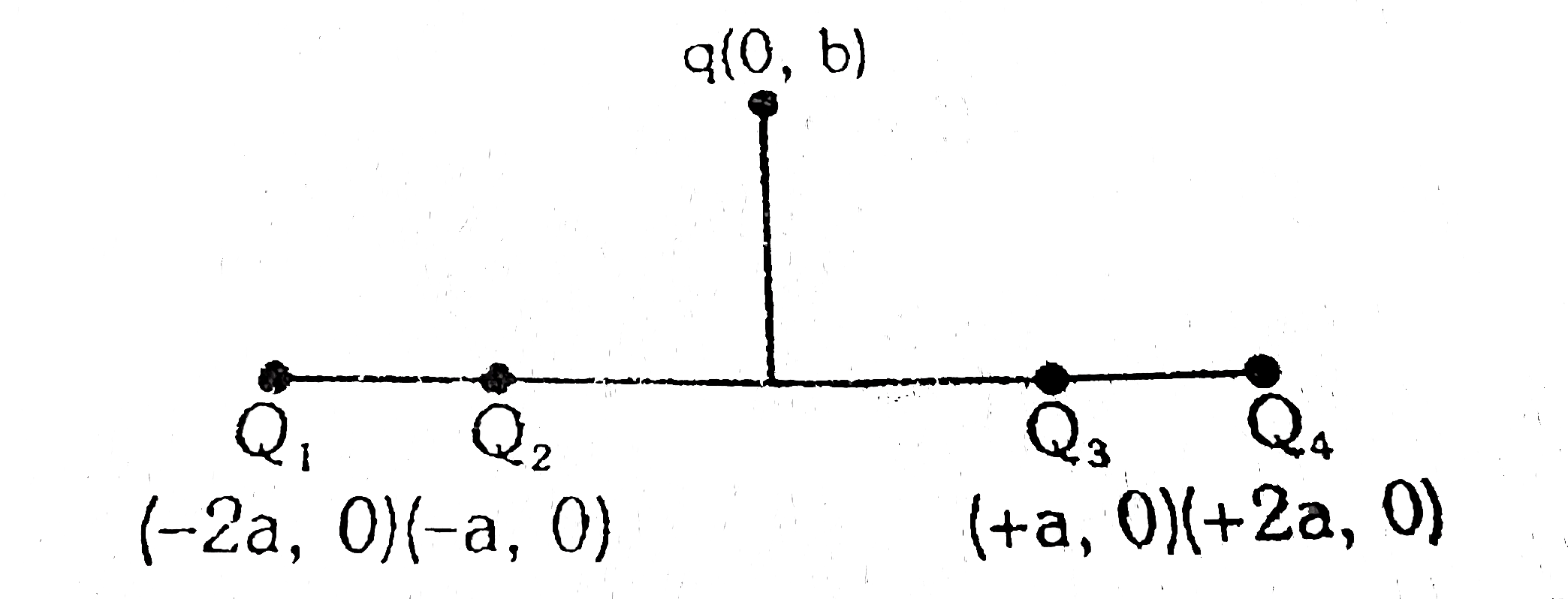For spherical symmetrical charge distribution, variation of electric potential with distance from centre is given in diagram Given that : V=q4πε0R0 for r≤R0andV=q4πε0r for r≥R0
Then which option (s) are correct :
 Solution in Gujrati
Solution in Gujrati
Total charge within 2R0 is q
Total electrostatic energy for r≤R0 is zero
At r=R0 electric field is discontinuous
There will be no charge anywhere except at r=R0
The correct Answer is:A, B, C, D
The given graph is of charged conducting sphere of radius R0. The whole charge q distributs on the surface of the sphere.
Topper's Solved these Questions
- MISCELLANEOUSBOOK - ALLEN CHAPTER - MISCELLANEOUSEXERCISE - REASONING TYPE
1 Videos
- MISCELLANEOUSBOOK - ALLEN CHAPTER - MISCELLANEOUSEXERCISE - MATCH THE COLUME TYPE
1 Videos
- MISCELLANEOUSBOOK - ALLEN CHAPTER - MISCELLANEOUSEXERCISE - Exercise-05(B)
19 Videos
- KINEMATICS (MOTION ALONG A STRAIGHT LINE AND MOTION IN A PLANE)BOOK - ALLEN CHAPTER - KINEMATICS (MOTION ALONG A STRAIGHT LINE AND MOTION IN A PLANE)EXERCISE - BEGINNER S BOX-7
8 Videos
- PHYSICAL WORLD, UNITS AND DIMENSIONS & ERRORS IN MEASUREMENT BOOK - ALLEN CHAPTER - PHYSICAL WORLD, UNITS AND DIMENSIONS & ERRORS IN MEASUREMENT EXERCISE - EXERCISE-IV
7 Videos
Similar Questions
statement 1 : For practical purposes, the earth is used as a reference at zero potencial in electrical circuits. statement 2 : The electrical potential of a sphere of radius R with charge Q uniformly distributed on the surface is given by Q4πε0R.
View SolutionFour charges Q1,Q2,Q3 and Q4 oof same magnitude are fixed along the x axis at x=−2a,−a,+a and +2a, respectively. A positive charge q is placed on the positive y axis at a distance b>0. Four options of the signs of these charges are given in List I. The direction of the forces on the charge q is given in List II. Match List I with List II and select the correct answer using the code given below the lists.

List-IList-II(P)Q1,Q2,Q3,Q4all positive(1)+x(Q)Q1,Q2 positive, Q3,Q4 negative(2)−x(R)Q1,Q4 positive ,Q2,Q3 negative(3)+y(S)Q1,Q3 positive , Q2,Q4 negative(4)−y
View SolutionA charge +q is fixed at each of the points x=x0, x=3x0, x=5x0,…………x=∞ on the x axis, and a charge −q is fixed at each of the points x=2x0, x=4x0, x=6x0, …………x=∞. Here x0 is a positive constant. Take the electric potential at a point due to a charge Q at a distance r from it to be Q/(4πε0r).Then, the potential at the origin due to the above system of
View SolutionA football player kicks a ball at an angle of 30∘ with an initial speed of 20 m/s. Assuming that the ball travels in a vertical plane, calculate (a) the time at which the ball reaches the highest point (b) the maximum height reached (c) the horizontal range of the ball (d) the time for which the ball is in the air, (g=10m/s2)
View SolutionAssertion : Gravitational forces do not depend on the medium between the masses.
Reason : Mediating particle responsible for gravitational force is graviton.
View SolutionThe concentric, thin metallic spheres of radii r_(1) and r_(2) (r_(1) gt r_(2)) carry charges q_(1) and q_(2) respectively. Then the electric potential at distance r (r_(2) lt r lt r_(1)) will be (1)/(4pi epsilon_(0)) times
View SolutionFor spherical symmetrical charge distribution, variation of electric potential with distance from centre is given in diagram Given that : V=(q)/(4pi epsilon_(0)R_(0)) for r le R_(0) and V=(q)/(4 piepsilon_(0)r) for r ge R_(0) Then which option (s) are correct : (1) Total charge within 2R_(0) is q (2) Total electrosstatic energy for r le R_(0) is non-zero (3) At r = R_(0) electric field is discontinuous (4) There will be no charge anywhere except at r lt R_(0)
View SolutionElectric potential is a scalar quantity. Due to a point charge charge q at distance r, the potential is given by V=q4π∈0r. A point charge q is placed at (3a,0) and another charge −2q is placed at (−3a,0).
If we plot a graph of potential (V) on x-axis it will be like:
View SolutionThe electrostatic potential phi_(r) , of a spherical symmetrical system kept at origin, is shown in the adjacent figure, and given as phi_(r)=(q)/(4 pi epsilon_(0)r)(r ge R_(0)) phi_(r)=(q)/(4 piepsilon_(0)R_(0))(r le R_(0)) Which of the following option is incorrect ?
View SolutionThe potential of an atom is given by V=V_(0)log_(e)(r//r_(0)) where r_(0) is a constant and r is the radius of the orbit Assumming Bohr's model to be applicable, which variation of r_(n) with n is possible (n being proncipal quantum number)?
View Solutionसममित गोलीय आवेश वितरण के लिए वैद्युत विभव का केनद्र से दूरी के साथ परिवर्तन चित्र में प्रदर्शित है। दिया है।

V=q4πε0R0r≤R0 के लिए
तथा V=q4πε0rr≥R0 के लिए कौन से विकल्प सही है
View SolutionAs shown in the figure, the symmetrical spherical body is at the origin, its constant electric potential. (phi_(r)) has given. phi _(r) = (q)/(4pi epsi _(0)) (r ge R _(0)) And phi_(r) =(q)/(4pi epsi _(0) R_(0)) (r le R _(0)) Then the following statement will be false.
View Solutionसममित गोलीय आवेश वितरण के लिए वैद्युत विभव का केन्द्र से दूरी के साथ परिवर्तन चित्र में प्रदर्शित है। दिया है ϕr=q4πε0r,(r≥R0) के लिए ϕr=q4πε0r,(r≤R0) के लिए कौन-से विकल्प सही है?

View SolutionElectric potential is a scalar quantity. Due to a point charge charge q at distance r, the potential is given by V=(q)/(4pi in_(0)r) . A point charge q is placed at (3a, 0) and another charge -2q is placed at (-3a, 0) . If we plot a graph of potential (V) on x-axis it will be like:
View SolutionThe electrostatic potential phi_(r) , of a spherical symmetrical system kept at origin, is shown in the adjacent figure, and given as phi_(r)=(q)/(4 pi epsilon_(0)r)(r ge R_(0)) phi_(r)=(q)/(4 piepsilon_(0)R_(0))(r le R_(0)) Which of the following option is incorrect ?
View Solution
